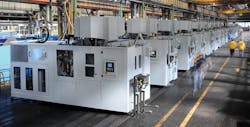Manufacturers of products and materials know what they mean when they speak of ‘automation’, but their definition is increasingly different from what theoreticians and developers of process technologies and networks are doing.
Manufacturers use ‘automation’ to mean controllers and robotics systems, but that’s only a portion of what the deep thinkers have in mind. They are not focused on automating a process or a plant – but rather of automating every process in every plant, and making all these operations flow freely in a vast industrial platform.
Robotics is part of that picture. Metalcasters use robots in places where human workers would be unproductive (setting cores), in danger (melt deck), incapable (handling heavy, fragile molds), or inaccurate (collecting dimensional data points on finished castings.) These are all effective uses for robots, but the current wave of robotics technology does not conceive of them as replacements for human labor – but rather an improvement on it. For starters, so-called “smart” robots have spatial awareness and responsive capability.
New robots are more mobile, in the sense that they can be positioned and repositioned more effectively thanks to more flexible range of movement. If necessary, they can interact with human workers too — the term for these systems is collaborative robotics (or ‘cobots’), at a grinding machine for example, or in a packaging/shipping operation.
More important is that state-of-the-art robots can interact with other machines (the melting furnace, for example) to correct defects or compensate for changed conditions. They can communicate the data they collect and execute order changes they receive. The robots are part of the information network.
Now, you may want that information, and you may be inclined to organize and secure it — for your plant productivity metrics, perhaps. But other machines are demanding that information: How many cores did your robot set this morning? What was the temperature on the iron sample drawn? When was the grinding completed on a pallet of valves?
For the past several years, machining operations nationwide have been enrolling in a open standard called MTConnect, which collects performance data on turning, grinding, and other CNC systems for evaluation, trouble-shooting, etc.
Now, the MTConnect database will be just a pass-through platform for an even broader network that will allow customers to identify their orders, send changes, update projections, and compare potential outcome scenarios for future planning.
Machine tool giant Mazak Corp., a pillar of the MTConnect establishment, linked with Cisco Systems and Memex Inc. (an MES developer) to “launch” machining operations into the Industrial Internet of Things. IIoT is the virtual network created by sensors, connective devices, analytics programs, and process controls, and tying together machines worldwide to optimize manufacturing performance across operating systems.
They introduced a device called SmartBox, represents a “leap in digital integration across manufacturing,” they declared. It functions as an extension of MTConnect to the CNC machine. The link that SmartBox creates to real-time manufacturing data is portrayed as a means for machinists to improve productivity and responsiveness to customer/market changes. Connectivity to machines and devices means manufacturers can enhance process monitoring and analysis, according to Mazak, including cyber security for assets and operations.
“With the development of SmartBox, Mazak continues to drive toward its iSmart Factory concept and connecting today’s shops to the IIoT to achieve levels of efficiency and productivity never before realized,” offered president Brian Papke. “And while our concept centers around open connectivity and the Internet, we at Mazak believe it is our moral obligation to also provide customers the highest level of security possible with SmartBox.” For that reason, Mazak implemented SmartBox into its own machine tool production plant.
The state of automation technology is well beyond the functions of process controllers or robots. While those devices are becoming more functional, more effective, the goal of automation is no longer to make a work cell perform better or a plant floor safer: your plant’s automation is a gateway to another dimension of data processing.
About the Author
Robert Brooks
Content Director
Robert Brooks has been a business-to-business reporter, writer, editor, and columnist for more than 20 years, specializing in the primary metal and basic manufacturing industries. His work has covered a wide range of topics, including process technology, resource development, material selection, product design, workforce development, and industrial market strategies, among others.

